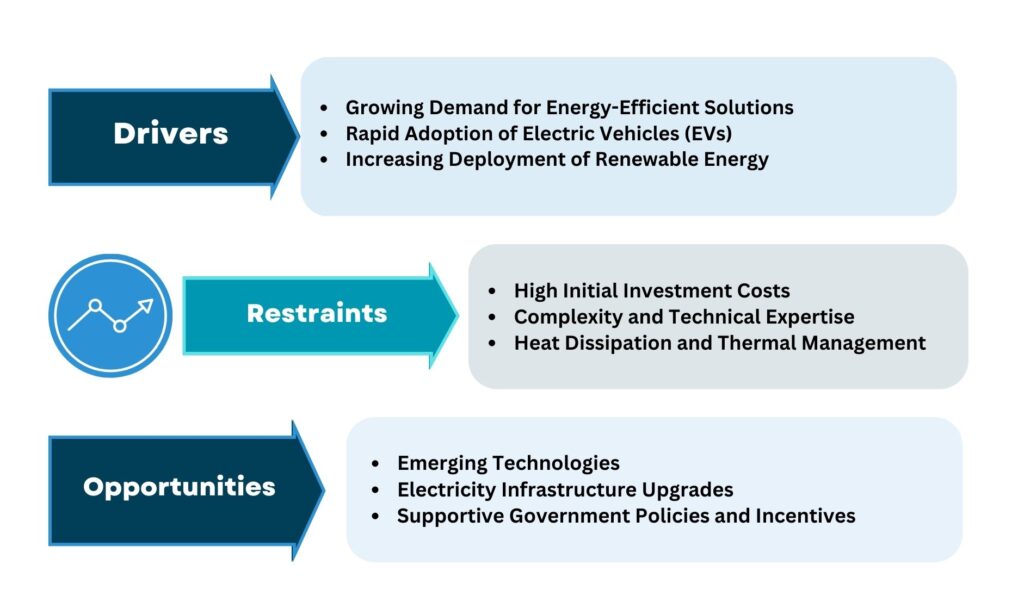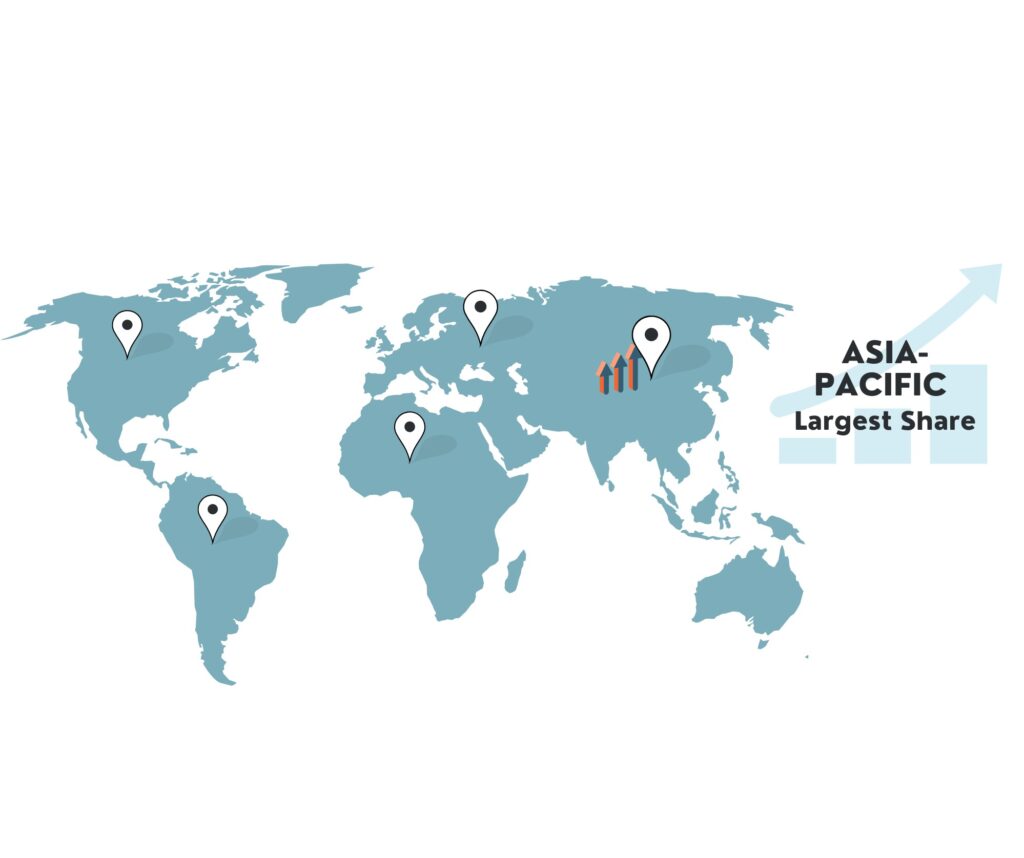Description
The Global Power Electronics Market size was USD 27.89 billion in 2022 and it is expected to grow to USD 41.80 billion in 2030 with a CAGR of 4.25% in the 2023-2030 period.
Global Power Electronics Market: Overview
The increasing demand for energy-efficient and battery-powered devices is likely to propel the global market over the forecast period. In addition, the urge for enhancing power infrastructure, increasing focus on the usage of renewable energy sources, and the growing trend of energy harvesting technologies are the major aspects that are anticipated to catapult the industry growth over the estimated duration.
Power electronics are solid-state circuitry devices that are used to alter and control electrical energy from the source to the load in an appropriate and effective way. It enable power management in order to improve energy conservation in a variety of applications such as consumer electronics, automotive, electric automobiles, and industrial systems.
Moreover, power electronics are capable of regulating the energy flow in unidirectional as well as bidirectional means, depending on the application and usage. At present, they are extensively used in renewable energy resources and electric vehicles to enhance the switching speed while avoiding power losses.
The intensifying need for power management devices and the rising adoption of power electronics in electric automobiles are the key influencing factors paving the way for the notable adoption of power electronics across various verticals including automotive, consumer electronics, energy & power, aerospace & defense, and other industries.
Global Power Electronics Market: Covid-19 Impact
The pandemic led to disruptions in global supply chains, affecting the production and distribution of power electronics components and products. Factory closures, restrictions on movement, and logistics challenges impacted the availability and delivery of raw materials and finished goods. The economic slowdown caused by the pandemic resulted in fluctuations in the demand for products across various sectors. Some industries experienced reduced demand due to lockdowns and restrictions, while others, such as the healthcare and data center sectors, saw an increased demand for power electronics components to support critical infrastructure. The pandemic’s impact on businesses and financial uncertainty caused delays in new projects and investments that would have required power electronic solutions. Companies and governments postponed or canceled projects, affecting the overall market growth. Many industries shifted their priorities during the pandemic to focus on immediate needs, such as safety measures and remote work setups. This shift might have diverted resources and attention away from planned power electronics projects.
Global Power Electronics Market: Growth Drivers

-
Growing Demand for Energy-Efficient Solutions:
Increasing awareness of environmental concerns and the need for energy conservation, there was a growing demand for energy-efficient power electronic solutions. Power electronics devices, such as inverters and converters, are essential for optimizing energy usage in various applications, including renewable energy systems, electric vehicles, and industrial equipment.
-
Rapid Adoption of Electric Vehicles (EVs):
The global shift towards electric mobility led to a surge in the demand for power electronics components and systems in the automotive sector. Power electronics are critical in EVs for managing battery charging, power distribution, and motor control.
-
Increasing Deployment of Renewable Energy:
The global push for clean energy sources resulted in the increased deployment of renewable energy systems, such as solar and wind power. Power electronics play a crucial role in converting, controlling, and managing the electricity generated from renewable sources, making them integral to the expansion of renewable energy infrastructure.
-
Industrial Automation and Robotics:
The increasing adoption of automation and robotics in industrial processes required advanced power electronic devices for motor control, power conversion, and energy efficiency. Power electronics enable precise control of motors and actuators, enhancing the overall efficiency of automated systems.
Global Power Electronics Market: Restraining factors
-
High Initial Investment Costs:
The initial investment required for implementing power electronics solutions, especially advanced and high-power devices, could be substantial. The high upfront costs might deter some end-users from adopting these technologies, particularly for smaller businesses or cost-sensitive industries.
-
Complexity and Technical Expertise:
Power electronics systems can be complex, requiring specialized technical expertise for design, installation, and maintenance. The lack of skilled professionals and the need for specialized training might limit the widespread adoption of power electronic solutions.
-
Heat Dissipation and Thermal Management:
Power electronics devices can generate significant amounts of heat, requiring effective thermal management solutions. Ensuring proper heat dissipation can be challenging, particularly in high-power applications, which may affect the efficiency and reliability of the systems.
-
Safety and Reliability Concerns:
Power electronic systems often operate at high voltages and currents, making safety a critical consideration. Ensuring the reliability and safety of these systems is essential, especially in applications where failure can have severe consequences.
Global Power Electronics Market: Opportunity factors
-
Emerging Technologies:
Advancements in wide-bandgap semiconductors, such as silicon carbide (SiC) and gallium nitride (GaN), offer opportunities for more efficient and compact power electronics solutions. These technologies enable higher power densities, reduced losses, and improved performance in power electronics devices.
-
Electricity Infrastructure Upgrades:
The need for modernizing and upgrading electricity infrastructure in various regions creates opportunities for power electronics solutions. As power grids evolve to accommodate distributed energy resources and microgrids, power electronics technologies become vital for managing power flow and maintaining grid stability.
-
Supportive Government Policies and Incentives:
Government initiatives promoting energy efficiency, renewable energy adoption, and clean transportation can drive demand for power electronics solutions. Supportive policies, regulations, and financial incentives create an enabling environment for the growth of the power electronics market.
Global Power Electronics Market: Challenges
-
Regulatory Compliance:
Power electronic systems need to comply with various regulatory standards and certifications, depending on the industry and application. Meeting these requirements can be time-consuming and costly for manufacturers and end-users.
-
Competition from Other Technologies:
Power electronics faces competition from other technologies and solutions that address similar challenges, such as mechanical systems and traditional electrical solutions. End-users may choose alternatives over power electronic in certain applications.
Global Power Electronics Market: Segmentation
- Based on Material: The market is segmented into Silicon (Si), Sapphire, Silicon Carbide (SiC), Gallium Nitride (GaN), and Others depending on the material segmentation. Among these, silicon (Si) dominates the market.
- Based on Device: Based on device segmentation, the market is further divided into Discrete, Module, and IC. Among these, the discrete device contributes significant revenue to the market.
- Based on Application: Based on Application segmentation, the market is divided into ICT, Consumer Electronics, Power, Industrial, Automotive, Aerospace & Defense, and Others. Among these, the power segment contributes a significant revenue share to the market.
- Based on Region: Based on Region, the market is segmented into five key geographical regions namely – North America, Europe, Asia Pacific, Latin America, and Middle East & Africa.
Global Power Electronics Market: Regional Insights
The global Power Electronics market is geographically segmented into North America, Europe, Asia Pacific, Latin America, and the Middle East and Africa. Each region has its own market dynamics and demand drivers, which can influence the revenue contribution and growth opportunities in the Power Electronics market.

The Asia Pacific region accounted for the largest share of the global industry. The region is expected to witness considerable growth and would continue its domination till 2025. The large market share and regional growth can be attributed to the lucrative opportunities in consumer electronics, automotive, ICT, and industrial applications in the Asia Pacific region.
The regional emergence as a promising manufacturing hub, particularly for the consumer electronics and automotive sectors, has led to a notable rise in production practices across the region by different leading manufacturers of the respective verticals. Furthermore, the cost & operational advantages and initiatives being taken by the governments of emerging countries, such as China, South Korea, India, and Singapore, are attracting investors and various industry leaders to establish their manufacturing units in this region. This is boosting the domestic manufacturing activities of different verticals in the Asia Pacific region and leading to the setting up of more and more industries. All these factors are expected to drive the growth of this market in the Asia Pacific region.
Global Power Electronics Market: Competitive Analysis
The Global Power Electronics Market is driven by various key players such as ABB Group, Renesas Electronics Corporation, Rockwell Automation, Inc., Microsemi Corporation, Texas Instruments, Inc., Infineon Technologies AG, STMicroelectronics NV, Fuji Electric Co., Ltd., Qualcomm, Inc., Mitsubishi Electric Corp.
Global Power Electronics Market: Recent Developments
- May 2023- Mitsubishi Electric Corporation developed a new structure for a silicon carbide metal-oxide-semiconductor field-effect transistor (SiC-MOSFET) embedded with a Schottky barrier diode (SBD), which the company has applied in a 3.3 kV full SiC power module, the FMF800DC-66BEW for large industrial equipment such as railways and DC power systems.
- January 2023 – Renesas Electronics announced a new gate driver IC designed to drive high-voltage power devices such as IGBTs (insulated gate transistors) and SiC (silicon carbide) MOSFETs for electric vehicle (EV) inverters. Moreover, as electric vehicles become more affordable, demand for automotive power semiconductors is increasing rapidly. The business continually increases its market share by providing various products to meet demand.


